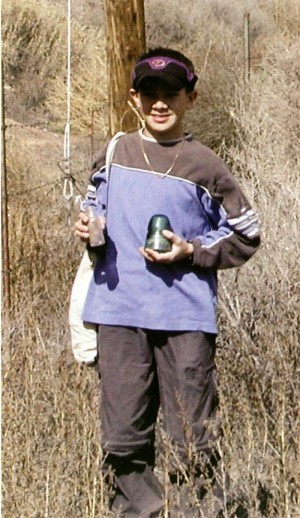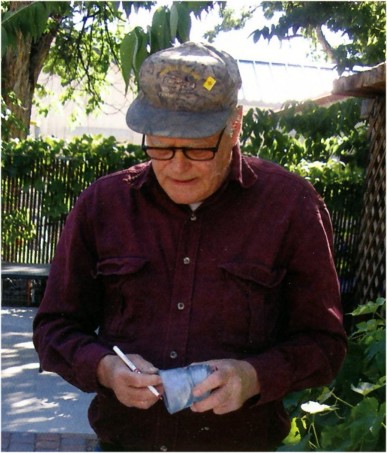Mystery Piece
By Powell Brown
Reprinted from "Crown Jewels of the Wire", March 2006, page 22
The Hunt
The whole thing started in late March 2004. I presented my good
friend Elliott Miller, for his birthday, an aqua Hemingray 42. From there, he
has become an avid collector. Due to constraints, he rarely gets out to
collect in the "boonies".

Elliott and I with a couple of finds.
Let's skip ahead to March 13, 2005: one week
before we move to Silver City, NM. Elliott still hasn't collected in the wild.
Lately, he had been talking of seeing purple insulators south of Albuquerque. I
felt this would be a good place to take him hunting. He took us to the exact
spot he had seen them, but the pile of debris they had been sitting on had been
hauled away. I didn't doubt him, however, as he has keen eyes and is always on
the lookout for insulators. Plus, many of the original insulators through the
area had been clear AmTels and Denvers - they would eventually turn purple.

Elliott under a pole with a CD 145 H.G.Co
and Edison oil bottle.
We
found tantalizing bits of CD 151's and Hemingray beehives along the ATSF right
of way through there, but nothing too special. Remembering some good hunting
grounds along the ATSF north of Bernalillo, we took off to check it out.
Access is limited, so we have to cover 1 /2 mile of track that I had looked
over earlier in December. If you have never collected in New Mexico, you are
missing out! The beauty of the land along a desert railroad is too much to
describe. Trudging through tumbleweeds, bushes, and sand has some sort of
"aura" to it. Well, today wasn't any different, the afternoon sun beat
down on us, but no mind was paid - we were collecting in wild New Mexico!

The Grand Canyon lounging in the grass at the
Canon City Tailgater. (Photo by Tom Katonak)
Around
one pole in the area that I had already checked, we found bits and pieces of
CD 126 Brookfields. Elliott
doesn't have a whole "blob" so we scrounge around the area. Finding nothing, we turn to
head on. At that moment, as I look back at the pole, a tiny piece of clearish
glass catches my eye. I walk over and dig it out. From the hole comes a beehive
that is totally encrusted in mud and dirt. Only the clean sliver of glass that
had been reaching out of the ground denoted its clearish (or so I thought)
color. Most of the dome is missing. During the December hunt, this must have
been missed due to the overcast sky and tumbleweeds around the pole. I offer it
to Elliott because it's his first hunt, but he doesn't want it, and we continue
our search. Nothing whole is found. A nice CD 126 dome, and a beat up CD 145
H.G. Co in sky blue I are all that come back. We head home satisfied and ready
for pizza and a lesson on cleaning insulators.
The Research
The following day, I clean up my finds, saving the oddball
beehive for last. I scrub off the compacted mud, moss, and grime. It sits on our
empty driveway, a sparkling gem. It has a very light aqua tinge to it. I examine
it carefully, noting that there is no embossing; there are 3 vertical bars on
the inside of the skirt, almost no petticoat, and some "silver"
bubbles. I have no idea what it is. I go through the McDougald's book and can
only come up with a Denver Grand Canyon or an unembossed American. I hoped it was the latter because the Grand
Canyons weren't very pricey. Still, the two options don't really match the
insulator. Confused, I call up my good friend and insulator expert, Tom
Katonak. After chatting and explaining the piece, his best I guess it that it is
a Grand Canyon. Without seeing it, he can't tell.

Calling Tom Katonak.

Grand Canyon with Mr. Miller's notes and hardware.
(Photo by Tom Katonak)
The Truth
Because this piece has peaked Tom's, Elliott's, and my curiosity, I
send it up to Tom after we move to Silver City. He examines it and, after much
conversation over the email, he is pretty sure it is a Grand Canyon. He keeps it
to show to Mike Miller, one of the most knowledgeable people on Denver glass.
The soonest they seem to be able to connect is during the '05 national in July.
Through a stroke of luck, they meet at the Canon City Tailgater. Tom shows Mr.
Miller the insulator and it IS a Denver Grand Canyon. To Mr. Miller's knowledge,
this is the 1st confirmed GC find in New Mexico! How did it get there? It
probably was a replacement insulator installed on the lines around the turn of
the century. Mr. Miller examines it some more, and it turns out as a very light
green aqua piece probably made by Robert Good Jr. before WFG! It is from mold 1
of the 3 beehive molds used. The "silver" bubbles are impurities that
bonded to the inside of the bubble during annealing. Although broken and
covered in alkali stains, this insulator deserves a spot in my collection. The
historical value of this insulator far exceeds any monetary standards, and that
is what

Mr. Miller examining the Grand Canyon
during the Canon City Tailgater.
(Photo
by Tom Katonak)
|
